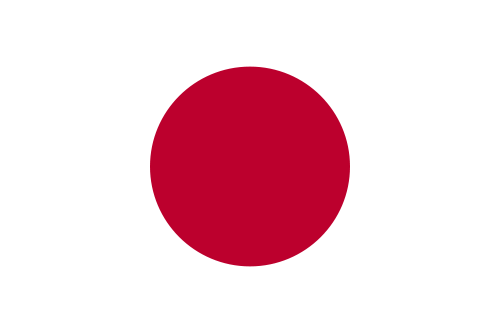
Country Flags by Continent
|
|
The national flag of Japan is a white rectangular flag with a large red disk (representing the sun) in the center. This flag is officially called Nisshōki (日章旗?, "sun-mark flag") in Japanese, but is more commonly known as Hinomaru (日の丸?, "sun disc").
The Nisshōki flag is designated as the national flag in Law Regarding the National Flag and National Anthem, which was promulgated and became effective on August 13, 1999. Although no earlier legislation had specified a national flag, the sun-disc flag had already become the de facto national flag of Japan. Two proclamations issued in 1870 by the Daijō-kan, the governmental body of the early Meiji Era, each had a provision for a design of the national flag. A sun-disc flag was adopted as the national flag for merchant ships under Proclamation No. 57 of Meiji 3 (issued on February 27, 1870), and as the national flag used by the Navy under Proclamation No. 651 of Meiji 3 (issued on October 27, 1870). Use of the Hinomaru was severely restricted during the early years of the American occupation after World War II, although restrictions were later relaxed.
In early Japanese history, the Hinomaru motif was used on flags of daimyos and samurai. An old history Shoku Nihongi says that Emperor Mommu used a flag of sun in his court in 701, and this is the first recorded use of sun-motif flag. The oldest existing flag is preserved in Umpo-ji temple, Yamanashi, which is older than 16th century, and it is handed down that the flag was given from Emperor Go-Reizei in 11th century. During the Meiji Restoration, both the sun disc and the Rising Sun Ensign of the Imperial Japanese Navy became major symbols in the emerging Japanese empire. Propaganda posters, textbooks, and films depicted the flag as a source of pride and patriotism. In Japanese homes, citizens were required to display the flag during national holidays, celebrations and other occasions as decreed by the government. Different tokens of devotion to Japan and its emperor featuring the Hinomaru motif became popular during the Second Sino-Japanese War and other conflicts. These tokens ranged from slogans written on the flag to clothing items and dishes that resembled the flag.
Public perception of the national flag varies. To some Japanese, the flag represents Japan, and no other flag could take its place. However, the flag is not frequently displayed due to its association with extreme nationalism. The use of the flag and the national anthem Kimigayo have been a contentious issue for Japan's public schools since the end of World War II. Disputes about their use have led to protests, lawsuits, and at least one suicide in Hiroshima Prefecture. To Okinawans, the flag represents the events of World War II and the subsequent U.S. military presence there. For some nations occupied by Japan, the flag is a symbol of aggression and imperialism. The Hinomaru was used as a tool against occupied nations for purposes of intimidation or subjugation. Despite the negative connotations, Western and Japanese sources claim the flag is a powerful and enduring symbol to the Japanese. Several military banners of Japan are based on the Hinomaru, including the sunrayed Naval Ensign. The Hinomaru also serves as a template for other Japanese flags in public and private use. |

